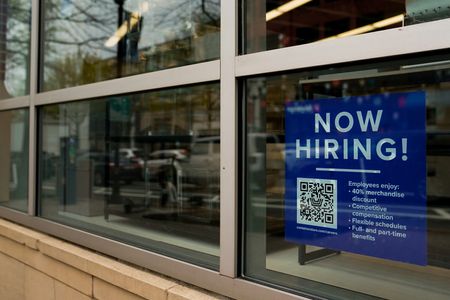By Lucia Mutikani
WASHINGTON (Reuters) – The number of Americans filing new claims for unemployment benefits fell more than expected last week, with applications in Massachusetts decreasing sharply, suggesting the labor market remains tight.
The steep decline in weekly jobless claims reported by the Labor Department on Thursday reversed the surge in the prior week, which had boosted them to the highest level since Oct. 30, 2021. That increase was largely blamed on an unusual jump in applications for unemployment insurance in Massachusetts.
The state’s Department of Unemployment Assistance said last week it was “experiencing an increase in fraudulent claim activities in which people attempted to gain access to active UI accounts or file new UI claims using stolen personal information so they can fraudulently obtain unemployment benefits.”
“The labor market is not deteriorating like we had thought as jobless claims were pumped up to recession levels by fraudulent applications for unemployment benefits,” said Christopher Rupkey, chief economist at FWDBONDS in New York.
Initial claims for state unemployment benefits declined 22,000 to a seasonally adjusted 242,000 for the week ended May 13. The drop was the largest since Nov. 20, 2021. Economists polled by Reuters had forecast 254,000 for the latest week.
Unadjusted claims decreased 18,605 to 215,810 last week, with filings in Massachusetts plunging by 14,042. Claims also fell considerably in Missouri and New Jersey, more than offsetting notable increases in Ohio and Illinois.
The labor market is being closely watched for signs of stress from the Federal Reserve’s fastest monetary policy tightening campaign since the 1980s. The U.S. central bank is expected to keep interest rates unchanged next month for the first time since it started hiking them in March 2022.
Though it has shown some signs of cooling, the labor market has remained tight, with 1.6 job openings for every unemployed person in March, well above the 1.0-1.2 range that is consistent with a jobs market that is not generating too much inflation.
“While we expect the Fed to leave rates steady at its June meeting, a resumption of rate hikes can’t be ruled out if labor market conditions don’t ease more significantly,” said Nancy Vanden Houten, lead U.S. economist at Oxford Economics in New York.
On Wall Street, the S&P 500 and the Nasdaq Composite were up, but the Dow Jones Industrial Average was slightly down in early afternoon trading. The dollar rose against a basket of currencies. U.S. Treasury prices fell.
HOUSING SLUMP CONTINUES
The jobless claims report covered the period when the government surveyed business establishments for the nonfarm payrolls portion of May’s employment report.
Claims were little changed between the April and May survey weeks. The economy created 253,000 jobs in April, with the unemployment rate falling back to a 53-year low of 3.4%.
The strength in the labor market is at odds with the Conference Board’s Leading Economic Index (LEI), a gauge of future economic activity, which has been flagging a recession since last year. The LEI fell 0.6% in April, posting its 13th straight monthly drop, the Conference Board said on Thursday.
The economy’s resilience is also evident in solid consumer spending, which prompted Walmart on Thursday to raise its annual sales and profit targets.
“We expect consumer spending to hold up until we see labor market slack materially spread,” said Shannon Seery, an economist at Wells Fargo in New York.
The number of people receiving benefits after an initial week of aid, a proxy for hiring, fell 8,000 to 1.799 million during the week ending May 6, the lowest level since early March, the claims report showed. The low so-called continuing claims suggest unemployed people are finding new work quickly.
Economists at Goldman Sachs speculated that the annual revision last month to the seasonal factor, the model that the government uses to strip out seasonal fluctuations from the data, could be distorting the continuing claims.
“We estimate that those distortions could exert a cumulative drag of up to 400,000 between April and September,” Goldman Sachs said in a note.
The Fed’s rate hikes have left the housing market mired in recession and manufacturing struggling, other reports showed on Thursday.
Existing home sales dropped 3.4% to a seasonally adjusted annual rate of 4.28 million units last month, the National Association of Realtors said.
The second straight monthly decline reflected tight inventory, with the NAR reporting prices rising in roughly half of the country, multiple offers and many homes being sold above list price. Housing inventory is 44% below its pre-pandemic levels.
“The housing market will remain moribund until mortgage rates start to fall later this year,” said Gus Faucher, chief economist at PNC Financial in Pittsburgh, Pennsylvania.
With higher borrowing eroding demand for goods, factory activity in the mid-Atlantic region continued to slump in May, though the pace of contraction slowed from the prior month.
The Philadelphia Fed’s general activity index improved to -10.4 this month from -31.3 in April. A reading below zero indicates contraction in the region’s manufacturing sector.
It was the ninth consecutive negative reading in the index, which covers factories in eastern Pennsylvania, southern New Jersey and Delaware. Though manufacturers were pessimistic about business conditions in the next six months, they planned to increase employment over that period.
“Re-shoring of supply chains, infrastructure projects and a stabilization in rates and demand could provide support to manufacturing activity over time,” said Rubeela Farooqi, chief U.S. economist at High Frequency Economics in New York.
(Reporting by Lucia Mutikani; Editing by Chizu Nomiyama and Paul Simao)





